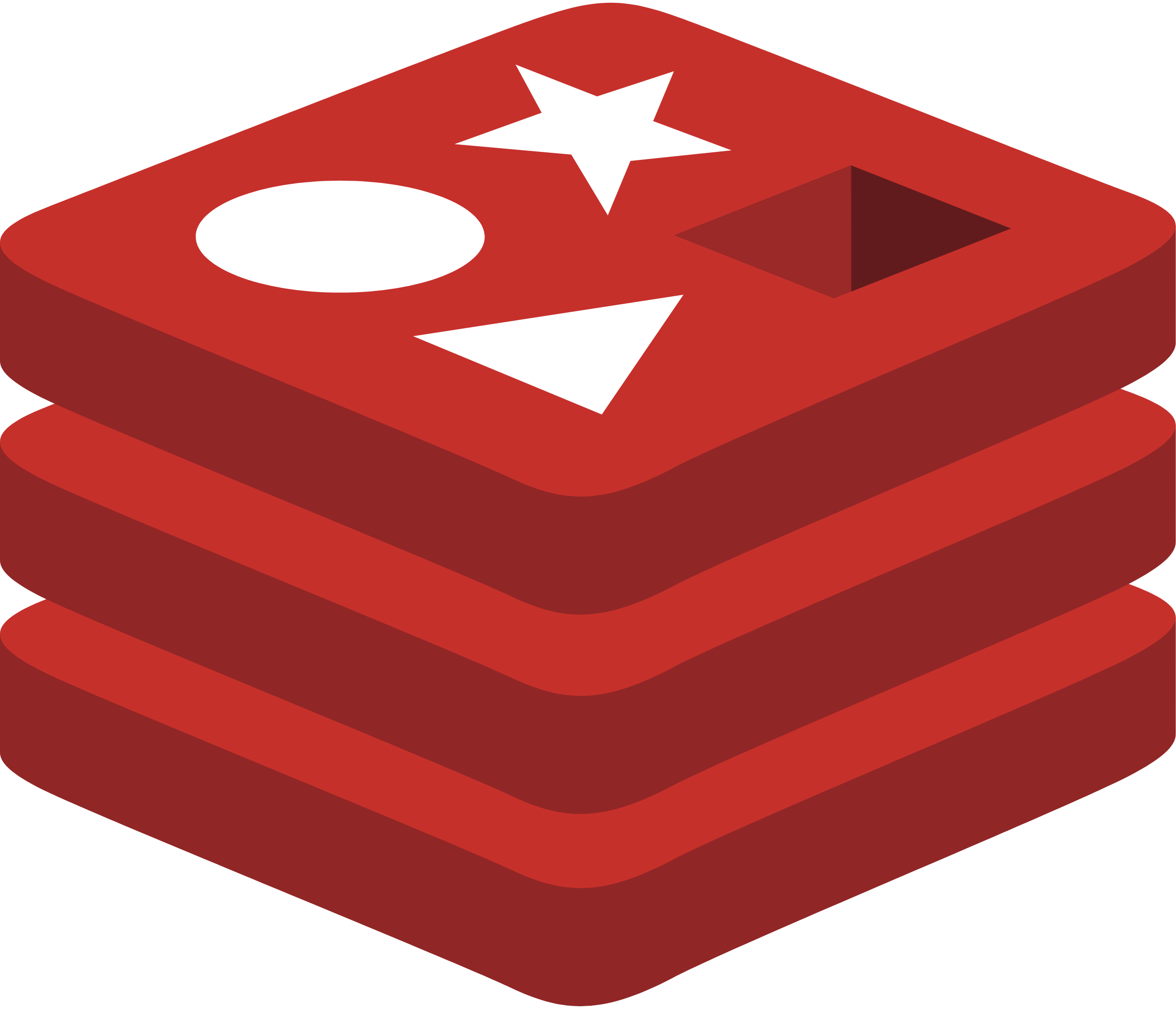LLM远不仅仅是Chat Model——LangChain基本概念与使用示例
前言
一图胜千言,LangChain已经成为当前LLM应用框架的事实标准,这篇文章就来对LangChain基本概念以及其具体使用场景做一个整理
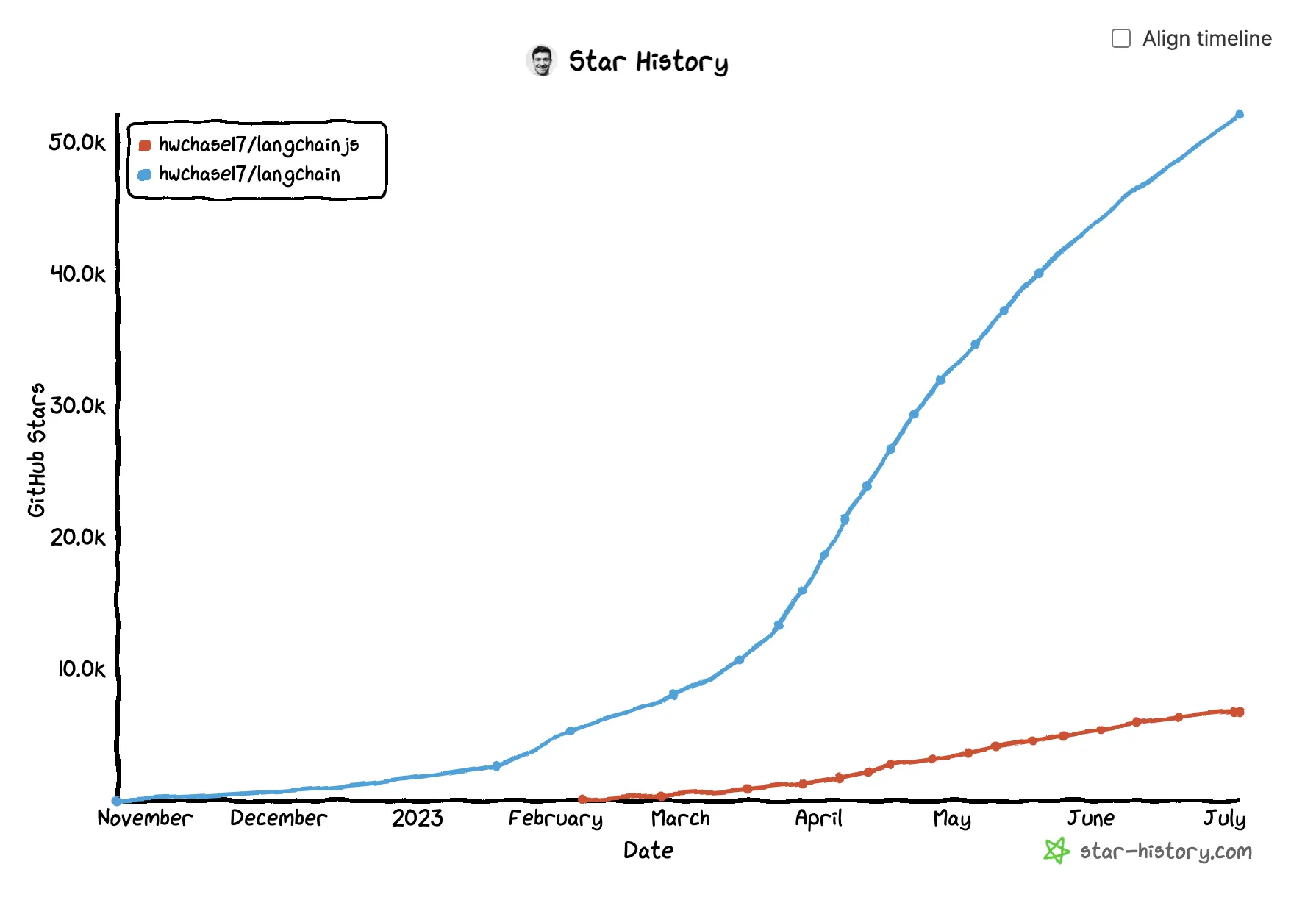
LangChain是什么
LangChain是一个基于大语言模型的应用开发框架,它主要通过两种方式规范和简化了使用LLM的方式:
- 集成:集成外部数据(如文件、其他应用、API数据等)到
LLM中 - Agent:允许
LLM通过决策与特定的环境交互,并由LLM协助决定下一步的操作
LangChain的优点包括:
- 高度抽象的组件:规范和简化与语言模型交互所需的各种抽象和组件
- 高度可自定义的Chains:提供了大量预置
Chains的同时,支持自行继承BaseChain并实现相关逻辑以及各个阶段的callback handler等 - 活跃的社区与生态:
Langchain团队迭代速度非常快,能快速使用最新的语言模型特性,该团队也有langsmith, auto-evaluator等其它优秀项目,并且开源社区也有相当多的支持
LangChain的主要组件
这是一张LangChain的组件与架构图(langchain python和langchain JS/TS的架构基本一致,本文中以langchain python来完成相关介绍),基本完整描述了LangChain的组件与抽象层(callback不在这张图中,在下方我们会另外介绍),以及它们之间的相关联系
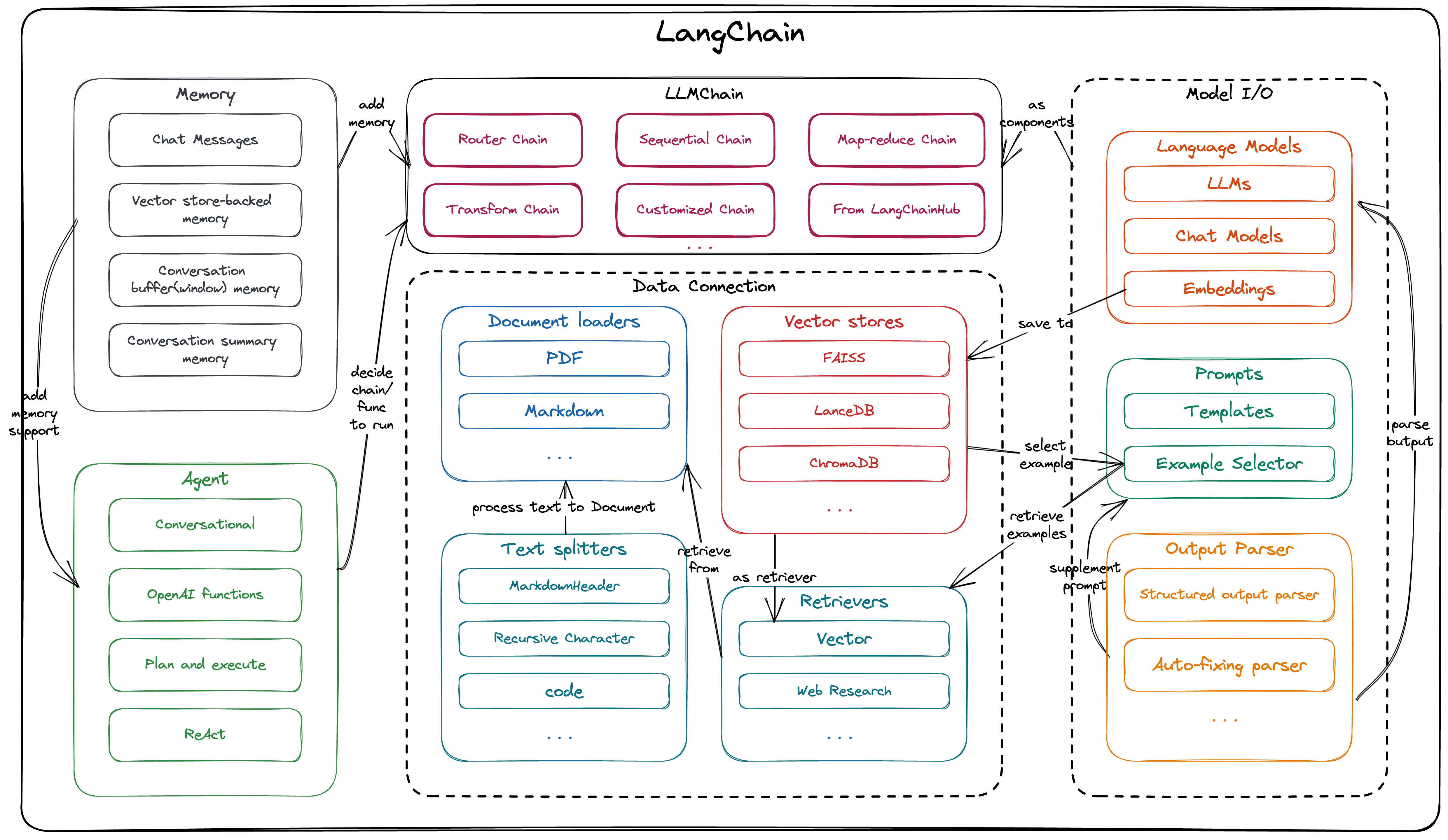
Model I/O
首先我们从最基本面的部分讲起,Model I/O 指的是和LLM直接进行交互的过程
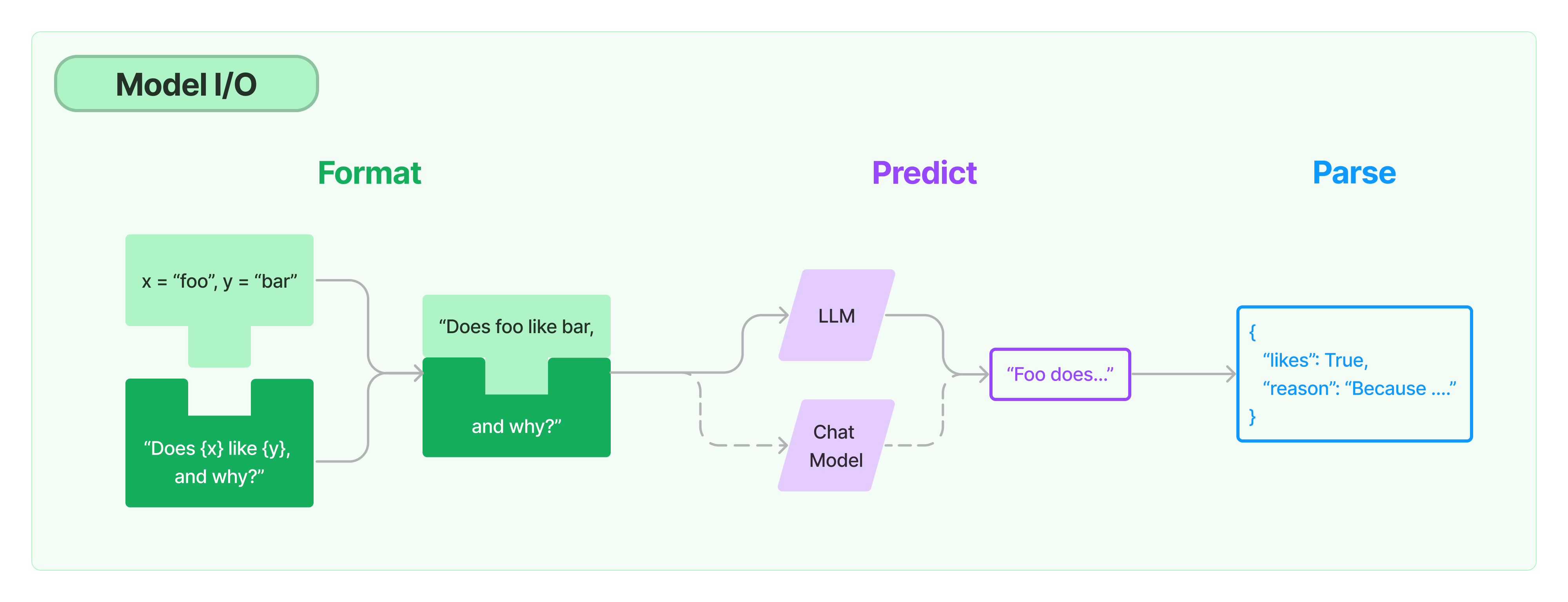
在Model I/O这一流程中,LangChain抽象的组件主要有三个:
下面我们展开介绍一下
⚠️注:下面涉及的所有代码示例中的OPENAI_API_KEY和OPENAI_BASE_URL需要提前配置好,OPENAI_API_KEY指OpenAI/OpenAI代理服务的API Key,OPENAI_BASE_URL指OpenAI代理服务的Base Url
Language Model
Language Model是真正与LLM / ChatModel进行交互的组件,它可以直接被当作普通的openai client来使用,在LangChain中,主要使用到的是LLM,Chat Model和Embedding三类Language Model
LLM: 最基础的通过“text in ➡️ text out”模式来使用的Language Model,另一方面,LangChain也收录了大量的第三方LLM
1
2
3
4
5
6from langchain.llms import OpenAI
llm = OpenAI(model_name="text-ada-001", openai_api_key=OPENAI_API_KEY, openai_api_base=OPENAI_BASE_URL)
llm("What day comes after Friday?")
# '\n\nSaturday.'Chat Model:
LLM的变体,抽象了Chat这一场景下的使用模式,由“text in ➡️ text out”变成了“chat messages in ➡️ chat message out”,chat message是指text + message type(System, Human, AI)- System - 告诉AI要做什么的背景信息上下文
- Human - 标识用户传入的消息类型
- AI - 标识AI返回的消息类型
以下是一个简单的
Chat Model使用示例1
2
3
4
5
6
7
8
9
10
11
12from langchain.chat_models import ChatOpenAI
from langchain.schema import HumanMessage, SystemMessage
chat = ChatOpenAI(model_name="gpt-4-0613", temperature=1, openai_api_key=OPENAI_API_KEY, openai_api_base=OPENAI_BASE_URL)
chat(
[
SystemMessage(content="You are an expert on large language models and can answer any questions related to large language models."),
HumanMessage(content="What’s the difference between Generic Language Models, Instruction Tuned Models and Dialog Tuned Models")
]
)
# AIMessage(content='Generic Language Models, Instruction-Tuned Models, and Dialog-Tuned Models are all various types of language models that have been trained according to different datasets and methodologies. They are used in different contexts according to their specific strengths. \n\n1. **Generic Language Models**: These models are trained on a broad range of internet text. They are typically not tuned to specific tasks and thus can be used across a wide variety of applications. GPT-3, used by OpenAI, is an example of a general language model.\n\n2. **Instruction-Tuned Models**: These are language models that are fine-tuned specifically to follow instructions given in a prompt. They are trained using a procedure called Reinforcement Learning from Human Feedback (RLHF), following an initial supervised fine-tuning which consists of human AI trainers providing conversations where they play both the user and an AI assistant. This model often includes comparison data - two or more model responses are ranked by quality.\n\n3. **Dialog-Tuned Models**: Like Instruction-Tuned Models, these models are also trained with reinforcement learning from human feedback, and especially shine in multi-turn conversations. However, these are specifically designed for dialog scenarios, resulting in an ability to maintain more coherent and context-aware conversations. \n\nIn essence, the difference among the three revolves around the breadth of their training and their specific use-cases. Generic Language Models are broad but may lack specificity; Instruction-Tuned Models are better at following specific instructions given in prompts; and Dialog-Tuned Models excel in carrying out more coherent and elongated dialogues.', additional_kwargs={}, example=False)另一方面,LangChain也收录了大量的**第三方Chat Model**
Embedding:
Embedding将一段文字向量化为一个定长的向量,有了文本的向量化表示我们就可以做一些像语义搜索,聚类选择等来选择需要的文本片段,如下是将一个embed任意字符串的示例:1
2
3
4
5
6
7
8
9
10
11from langchain.embeddings import OpenAIEmbeddings
embeddings = OpenAIEmbeddings(openai_api_key=OPENAI_API_KEY, openai_api_base=OPENAI_BASE_URL)
text_embedding = embeddings.embed_query("To embed text(it can have any length)")
print (f"Your embedding's length: {len(text_embedding)}")
print (f"Here's a sample: {text_embedding[:5]}...")
'''
Your embedding's length: 1536
Here's a sample: [-0.03194352, 0.009228715, 0.00807182, 0.0077545005, 0.008256923]...
'''
Prompts
Prompt指用户的一系列指令和输入,是决定Language Model输出内容的唯一输入,主要用于帮助模型理解上下文并生成相关和连贯的输出,如回答问题、拓写句子和总结问题。在LangChain中的相关组件主要有Prompt Template和Example selectors,以及后面会提到的辅助/补充Prompt的一些其它组件
Prompt Template: 预定义的一系列指令和输入参数的
prompt模版,支持更加灵活的输入,如支持**output instruction(输出格式指令), partial input(提前指定部分输入参数), examples(输入输出示例)**等;LangChain提供了大量方法来创建Prompt Template,有了这一层组件就可以在不同Language Model和不同Chain下大量复用Prompt Template了,Prompt Template中也会有下面将提到的Example selectors, Output Parser的参与Example selectors: 在很多场景下,单纯的instruction + input的
prompt不足以让LLM完成高质量的推理回答,这时候我们就还需要为prompt补充一些针对具体问题的示例,LangChain将这一功能抽象为了Example selectors这一组件,我们可以基于关键字,相似度(通常使用MMR/cosine similarity/ngram来计算相似度, 在后面的向量数据库章节中会提到)。为了让最终的prompt不超过Language Model的token上限(各个模型的token上限见下表),LangChain还提供了LengthBasedExampleSelector,根据长度来限制example数量,对于较长的输入,它会选择包含较少示例的提示,而对于较短的输入,它会选择包含更多示例Model Max Tokens Training Data gpt-4 8,192 tokens Up to Sep 2021 gpt-4-0613 8,192 tokens Up to Sep 2021 gpt-4-32k 32,768 tokens Up to Sep 2021 gpt-4-32k-0613 32,768 tokens Up to Sep 2021 gpt-3.5-turbo 4,096 tokens Up to Sep 2021 gpt-3.5-turbo-16k 16,384 tokens Up to Sep 2021 gpt-3.5-turbo-0613 4,096 tokens Up to Sep 2021 gpt-3.5-turbo-16k-0613 16,384 tokens Up to Sep 2021 text-davinci-003 4,097 tokens Up to Jun 2021 text-davinci-002 4,097 tokens Up to Jun 2021 code-davinci-002 8,001 tokens Up to Jun 2021
Output Parser
通常我们希望Language Model的输出是固定的格式,以支持我们解析其输出为结构化数据,LangChain将这一诉求所需的功能抽象成了Output Parser这一组件,并提供了一系列的预定义Output Parser,如最常用的Structured output parser, List parser,以及在LLM输出无法解析时发挥作用的Auto-fixing parser和Retry parser
Output Parser需要和Prompt Template, Chain组合使用:
- Prompt Template: 在
Prompt Template中通过指定partial_variables为Output Parser的format,即可在prompt中补充让模型输出所需格式内容的指令 - Chain: 在
Chain中指定Output Parser,并使用Chain的predict_and_parse / apply_and_parse方法启动Chain,即可直接输出解析后的数据
使用示例
以下是一个完整的组合Prompt Template, Output Parser和Chain的具体用例:
1 | from langchain.chat_models import ChatOpenAI |
输出如下:
1 | { |
Data connection
正如我在文章开头的LangChain是什么一节中提到的,集成外部数据到Language Model中是LangChain提供的核心能力之一,也是市面上很多优秀的大语言模型应用成功的核心之一(Github Copilot Chat,网页聊天助手,论文总结助手,youtube视频总结助手…),在LangChain中,Data connection这一层主要包含以下四个抽象组件:
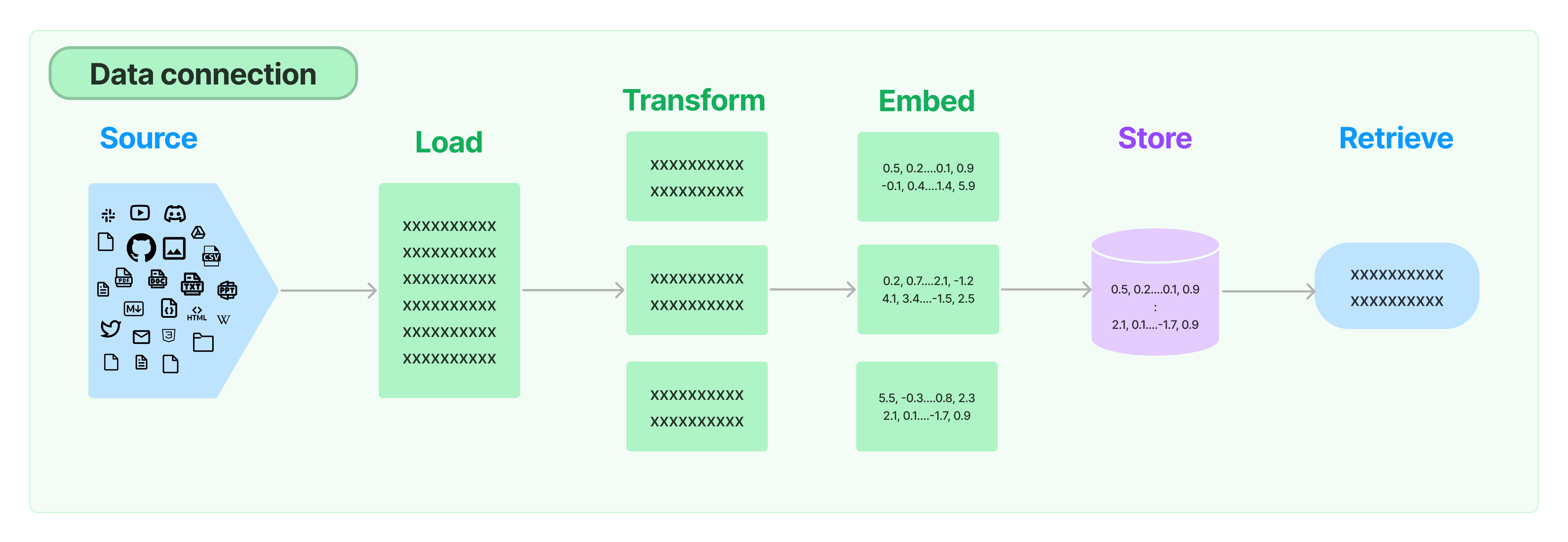
下面我们展开介绍一下
Document loaders
为了补全LLM的上下文信息,给予其足够的提示,我们需要从各类数据源获取各类数据,这也就是LangChain抽象的Document loaders这一组件的功能
使用Document loaders可以将源中的数据加载为Document。Document由一段文本和相关元数据组成。例如,有用于加载简单.txt文件的,用于加载相对结构化的markdown文件的,用于加载任何网页文本内容,甚至用于加载解析YouTube视频的脚本
同时LangChain还收录了海量的第三方Document loaders,以下是一个使用NotionDBLoader来加载notion database中的page为Document的示例:
1 | from langchain.document_loaders import NotionDBLoader |
Document transformers
当我们加载Document到内存后,我们通常还会希望将他们尽可能的结构化 / 分块,以进行更加灵活的操作
最简单的例子是,我们很多时候都需要将一个长文档拆分成更小的块,以便放入模型的上下文窗口中;LangChain有许多内置的Document transformers(大部分都是Text Spliter),可以轻松地拆分、合并、筛选和以其他方式操作文档,一些常用的Document transformers如下:
| Document transformers | 功能 |
|---|---|
| LatexTextSplitter | 沿着Latex标题、标题、枚举等分割文本 |
| MarkdownHeaderTextSplitter | 沿着指定的Markdown的section header分割 |
| NLTKTextSplitter | 使用NLTK的分割器 |
| PythonCodeTextSplitter | 沿着Python类和方法的定义分割文本 |
| RecursiveCharacterTextSplitter | 用于通用文本的分割器。它以一个字符列表为参数,尽可能地把所有的段落(然后是句子,然后是单词)放在一起 |
| SpacyTextSplitter | 使用Spacy的分割器 |
| TokenTextSplitter | 根据openAI的token数进行分割 |
同时LangChain也收录了很多第三方的Document transformers(如基于爬虫中常见的beautiful soup, 基于OpenAI打metadata tag的等等)
Vector stores
在前面的Prompt一节中我们提到了Example selectors,那么我们要如何找到相关示例呢?通常这个答案就是向量数据库
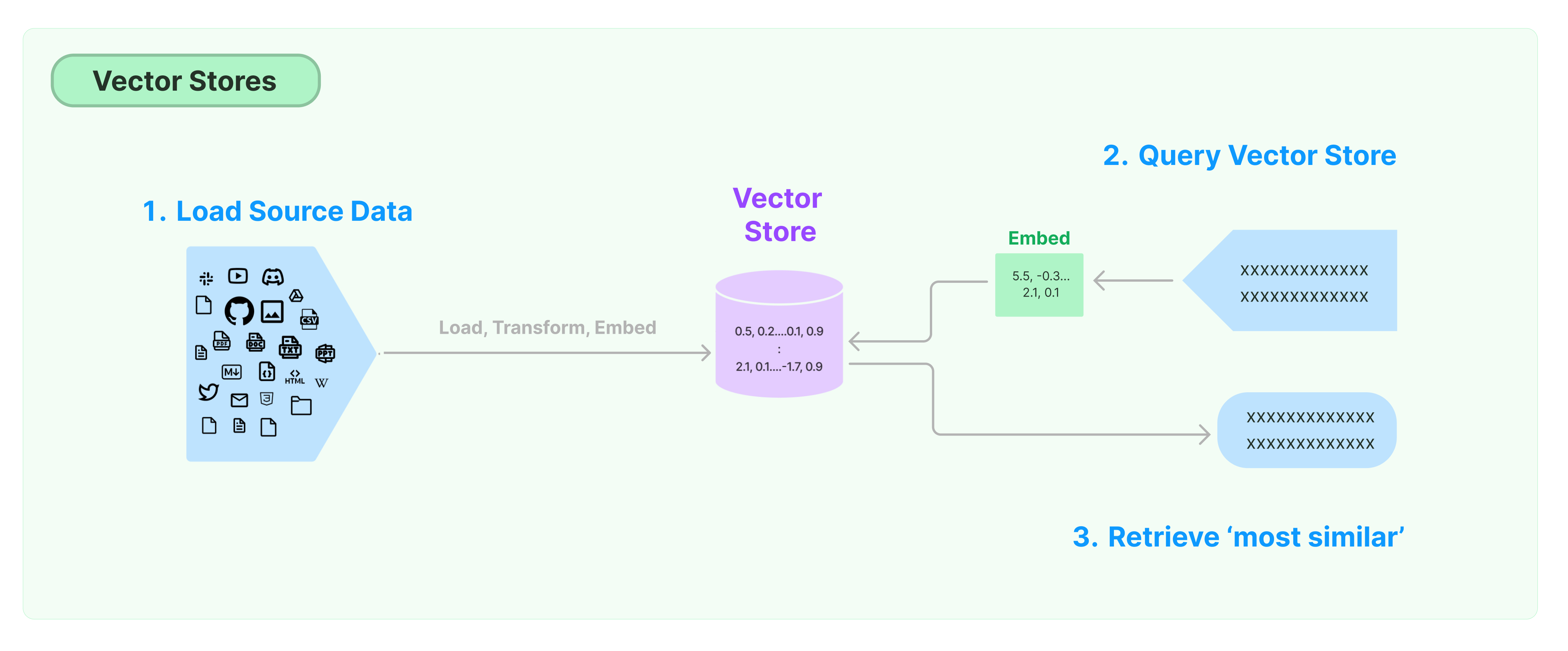
存储和搜索非结构化数据的最常见方式之一是将其向量化(embedding)并存储所得到的嵌入向量,然后在查询时向量化非结构化查询并检索与嵌入的查询最相似的向量。Vector stores负责存储向量化数据并提供向量搜索的功能,常见的向量数据库包括FAISS, Milvus, Pinecone, Weaviate, Chroma等,日常使用更常用的是FAISS
同时LangChain也收录了很多第三方的Vector Stores,提供更加强大的向量搜索等功能
Retrievers
Retrievers是LangChain提供的将Document与Language Model相结合的组件
LangChain中有许多不同类型的Retrievers,但最广泛使用的就是VectoreStoreRetriever,我们可以直接把它当做连接向量数据库和Language Model的中间层,并且VectoreStoreRetriever的使用也很简单,直接retriever = db.as_retriever()即可
当然我们还有很多其它的Retrievers如Web search Retrievers等,LangChain也收录了很多第三方的Retrievers
使用示例
以下就是一个使用向量数据库 + VectoreStoreRetriever + QA Chain的QA应用示例:
1 | from langchain.chat_models import ChatOpenAI |
执行后verbose输出日志如下:
You have 1 document
You have 74663 characters in that document
Now you have 29 documents that have an average of 2,930 characters (smaller pieces)> Entering new chain…
Prompt after formatting:
System: Use the following pieces of context to answer the users question.
If you don’t know the answer, just say that you don’t know, don’t try to make up an answer.
----------------
… Human: What does the author describe as good work?
The author describes working on things that aren’t prestigious as a sign of good work. They believe that working on unprestigious types of work can lead to the discovery of something real and that it indicates having the right kind of motives. The author also mentions that working on things that last, such as paintings, is considered good work.
Chains
接下来就是LangChain中的主角——Chains了,Chains是LangChain中为连接多次与Language Model的交互过程而抽象的重要组件,它可以将多个组件组合在一起以创建一个单一的、连贯的任务,也可以嵌套多个Chain组合在一起,或者将Chain与其他组件组合来构建更复杂的Chain
除了单一Chain外,常用的几个Chains如下:
Router Chain
在一些场景下,我们需要根据输入 / 上下文决定使用哪一条Chain,甚至哪一个Prompt,Router Chain就提供了诸如MultiPromptChain, LLMRouterChain等一系列用于决策的Chain(这与后面我们会提到的Agent有类似的地方)
Router Chain由两部分组成:
- Router Chain本身:负责决定下一个目标Chain
- 目标Chains:Router Chain可以路由到的目标Chain
Sequential Chain
顾名思义,顺序执行的串行Chain,其中最简单的SimpleSequentialChain非常简单粗暴,SimpleSequentialChain的每个子Chain都有一个单一的输入/输出,并且一个步骤的输出是下一步的输入
而高阶一些的SequentialChain则允许多输入输出,并且我们可以通过添加后面会提到的Memory等来提高其推理表现
Map-reduce Chain
Map-reduce Chain主要用于summary的场景,针对那些超长的文档,首先我们通过前面提到过的TextSpliter按一定规则分割文档为更小的Chunks(通常使用RecursiveCharacterTextSplitter,如果Document是结构化的可以考虑使用指定的TextSpliter),然后对每个分割的部分执行”map-chain”,收集全部”map-chain”的输出后,再执行”reduce-chain”,获得最终的summary输出

使用示例
下面就是一个Router Chain中的MultiPromptChain的具体示例:
1 | from langchain.chains.router import MultiPromptChain |
执行后verbose输出日志如下:
Entering new chain…
Prompt after formatting:
***Given a raw text input to a language model select the model prompt best suited for the input. You will be given the names of the available prompts and a description of what the prompt is best suited for. You may also revise the original input if you think that revising it will ultimately lead to a better response from the language model.<< FORMATTING >>
Return a markdown code snippet with a JSON object formatted to look like:
2
3
4
"destination": string \ name of the prompt to use or "DEFAULT"
"next_inputs": string \ a potentially modified version of the original input
}REMEMBER: “destination” MUST be one of the candidate prompt names specified below OR it can be “DEFAULT” if the input is not well suited for any of the candidate prompts.
REMEMBER: “next_inputs” can just be the original input if you don’t think any modifications are needed.<< CANDIDATE PROMPTS >>
physics: Good for answering questions about physics
math: Good for answering math questions<< INPUT >>
What is black body radiation?<< OUTPUT >>***
> Finished chain.
physics: {‘input’: ‘What is black body radiation?’}
> Entering new chain…
Prompt after formatting:
***You are a very smart physics professor. You are great at answering questions about physics in a concise and easy to understand manner. When you don’t know the answer to a question you admit that you don’t know.
Here is a question:
What is black body radiation?***> Finished chain.
Memory
Memory可以帮助Language Model补充历史信息的上下文,LangChain中的Memory是一个有点模糊的术语,它可以像记住你过去聊天过的信息一样简单,也可以结合向量数据库做更加复杂的历史信息检索,甚至维护相关实体及其关系的具体信息,这取决于具体的应用
通常Memory用于较长的Chain,能一定程度上提高模型的推理表现
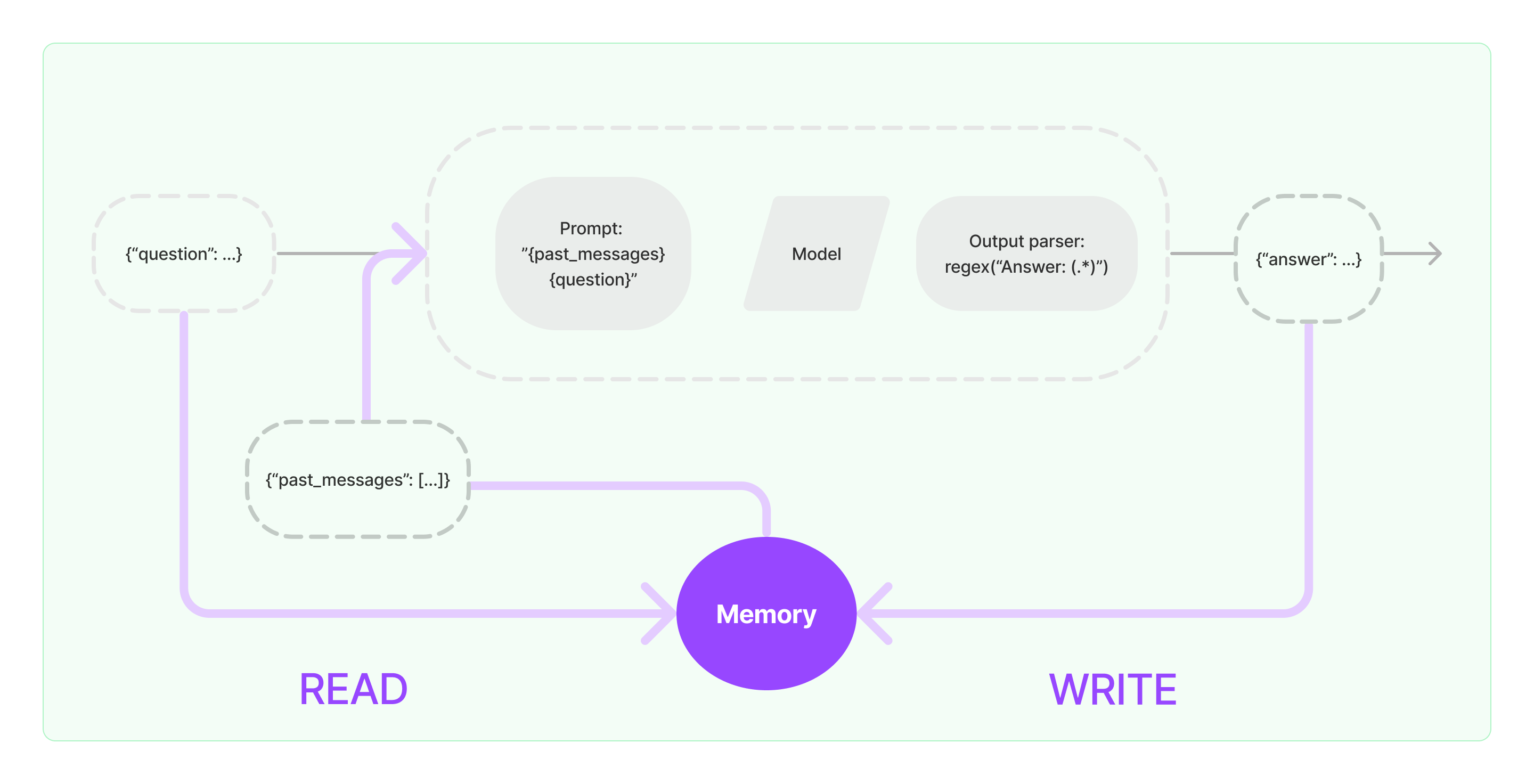
常用的Memory类型如下:
- Chat Messages
最简单Memory,将历史Chat记录作为补充信息放入prompt中 - Vector store-backed memory
基于向量数据库的Memory,将memory存储在向量数据库中,并在每次调用时查询TopK的最“重要”的文档
这与大多数其他内存类的不同之处在于,它不显式跟踪交互的顺序,最多基于部分元数据筛选一下向量数据库的查询范围 - Conversation buffer(window) memory
保存一段时间内的历史Chat记录,它只使用最后K个记录(仅保持最近交互的滑动窗口),这样buffer也就不会变得太大,避免超过token上限 - Conversation summary memory
这种类型的Memory会随着Chat的进行创建对话的摘要,并将当前摘要存储在Memory中,用于后续对话的history提示;这种memory方案对长会话非常有用,但频繁的总结摘要会耗费大量的token - Conversation Summary Buffer Memory
结合了buffer memory和summary memory的策略,依旧会在内存中保留最后的一些Chat记录作为buffer,并在buffer的总token数达到预置的上限后,对所有Chat记录总结摘要作为SystemMessage并清理其它历史Messages;这种memory方案结合了buffer memory和summary memory的优点,既不会频繁地总结摘要消耗token,也不会让buffer缺失过多信息
使用示例
下面是一个Conversation Summary Buffer Memory在ConversationChain中的使用示例,包含了切换会话时恢复现场memory的方法以及自定义summary prompt的方法:
1 | from langchain.chains import ConversationChain |
执行后verbose输出日志如下:
> Entering new chain…
Prompt after formatting:
***The following is a friendly conversation between a human and an AI. The AI is talkative and provides lots of specific details from its context. If the AI does not know the answer to a question, it truthfully says it does not know.
Current conversation:
System: The human asks the AI about its opinion on artificial intelligence and is told that it is a force for good that can help humans reach their full potential. The human then inquires about the differences between python and golang, with the AI explaining that python is a high-level interpreted language for general-purpose programming, while golang is a statically typed compiled language often used for building distributed systems.
Human: Then if I want to build a distributed system, which language should I choose?
AI: If you want to build a distributed system, I would recommend golang as it is a statically typed compiled language that is designed to facilitate concurrency and performance.
Human: Is there any well-known distributed system built with golang?
AI:***> Finished chain.
> Entering new chain…
Prompt after formatting:
***The following is a friendly conversation between a human and an AI. The AI is talkative and provides lots of specific details from its context. If the AI does not know the answer to a question, it truthfully says it does not know.
Current conversation:
System: The human asks the AI about its opinion on artificial intelligence and is told that it is a force for good that can help humans reach their full potential. The human then inquires about the differences between python and golang, with the AI explaining that python is a high-level interpreted language for general-purpose programming, while golang is a statically typed compiled language designed to facilitate concurrency and performance, thus better suited for distributed systems. The AI recommends golang for building distributed systems.
Human: Is there any well-known distributed system built with golang?
AI: Yes, there are several well-known distributed systems built with golang. These include Kubernetes, Docker, and Consul.
Human: Is there a substitutes for Kubernetes in python?
AI:***> Finished chain.
’Yes, there are several substitutes for Kubernetes in python. These include Dask, Apache Mesos and Marathon, and Apache Aurora.’
Agent
在一些场景下,我们需要根据用户输入灵活地调用LLM和其它工具(LangChain将工具抽象为Tools这一组件),Agent为这样的应用程序提供了相关的支持
Agent可以访问一套工具,并根据用户输入确定要使用Chain或是Function,我们可以简单的理解为他可以动态的帮我们选择和调用Chain或者已有的工具
常用的Agent类型如下:
Conversational Agent
这类Agent可以根据Language Model的输出决定是否使用指定的Tool,以及使用什么Tool(这里的Tool也可以是一个Chain),以及时的为Model I/O的过程补充信息
OpenAI functions Agent
类似Conversational Agent,但它能够让Agent更进一步地帮忙提取指定Tool的参数等,甚至使用多个Tools
Plan and execute Agent
抽象Agent“决定做什么”的过程为“planning what to do”和“executing the sub tasks”(这种方法来自"Plan-and-Solve"这一篇论文),其中“planning what to do”这一步通常完全由LLM完成,而“executing the sub tasks”这一任务则通常由更多的Tools来完成
ReAct Agent
结合对LLM输出的归因和执行,类似OpenAI functions Agent,提供了一个更加明确的框架以及由论文支撑的方法

Self ask with search
这类Agent会基于LLM的输出,自行调用Tools以及LLM来进行额外的搜索和自查,以达到拓展和优化输出的目的
总结
LangChain 中的Data Connection将LLM与万物互联,给LangChain构建的应用带来了无限可能,而Agent又为应用开发中非常常见的”事件驱动“这一开发框架提供了偷懒的途径,将分支决策的工作交给LLM,这又进一步简化了应用开发的工作;结合基于高度抽象的Model I/O及Memory等组件,LangChain让开发者能够更快,更好更灵活地实现 LLM 助手、对话机器人等应用,极大地降低了 LLM 的使用门槛




